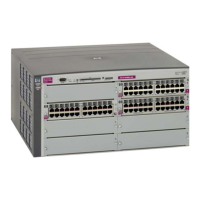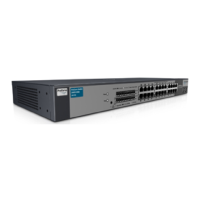Accessing the switch 15
Configuring SNMP trap hosts
SNMPv1 trap host
1. Configure a user with no authentication or password.
/c/sys/ssnmp/snmpv3/usm 10 (Configure user named “v1trap”)
name "v1trap"
2. Configure an access group and group table entries for the user. Use the following command to specify which
traps can be received by the user:
/c/sys/ssnmp/snmpv3/access <x>/nview
/c/sys/ssnmp/snmpv3/access 10 (Define access group to view SNMPv1 traps)
name "v1trap"
model snmpv1
nview "iso"
/c/sys/ssnmp/snmpv3/group 10 (Assign user to the access group)
model snmpv1
uname v1trap
gname v1trap
In this example the user will receive the traps sent by the switch.
3. Configure an entry in the notify table.
/c/sys/ssnmp/snmpv3/notify 10 (Assign user to the notify table)
name v1trap
tag v1trap
4. Specify the IP address and other trap parameters in the Target Address( targetAddr) and Target Parameters
(targetParam) tables. Use the following command to specify the user name used with this targetParam table:
c/sys/ssnmp/snmpv3/tparam <x>/uname
/c/sys/ssnmp/snmpv3/taddr 10 (Define an IP address to send traps)
name v1trap
addr 47.80.23.245
taglist v1trap
pname v1param
/c/sys/ssnmp/snmpv3/tparam 10 (Specify SNMPv1 traps to send)
name v1param
mpmodel snmpv1
uname v1trap
model snmpv1
5. Use the community table to define the community string used in the traps.
/c/sys/ssnmp/snmpv3/comm 10 (Define the community string)
index v1trap
name public
uname v1trap
